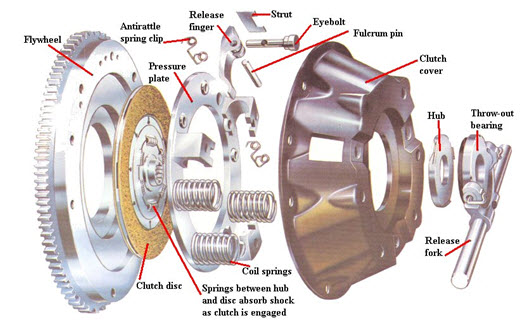Site pages
Current course
Participants
General
Module 1. Tractor Mechanics
Module 2. Traction
Module 3. Introduction to Transmission System
Module 4. Clutch System
Module 5. Gear Box
Module 6. Differential and Final drive
Module 7. Brakes
Module 8. Steering system
Module 9. Hydraulics
Module 10. Power Transmission
Module 11. Human Factors
Lesson 10. Working principles of Clutch and its Construction and clutch materials
Clutch System
Requirement of Clutch
A clutch is required to connect the rotational power from the flywheel of the engine to the gearbox especially at the time of selection of proper gear, specially at the time of starting, or moving the tractor from position of rest.
The clutch used in automobiles can be classified as follows:
Friction type clutchCone clutch
Plate type friction clutchWet type clutch
Dry type clutch
Single plate clutch
Axial spring type single plate clutch
Diaphragm type single plate clutch
Multi plate clutch
Wet type clutch
Cone clutch
Liquid clutch
The agricultural tractors mostly use axial spring
Clutch, as the name suggests, uses a clutching force (axial force) to transmit the rotational motion from one shaft to another. Most tractor clutches are frictional clutches.

To transmit power from shaft 1 to shaft 2, the flat discs are forced together with a force (axial force), F. the friction between the discs, A and B, causes the rotational motion of shaft 1 to be transmitted to shaft 2.
The torque that this system can transmit is given by
T= uFR
Where u = coefficient of friction between the two discs A and B
F = Axial force with which the two discs are put together.
R = mean effective radius of the friction surface of the discs.
Requirements of a good clutch
The clutch should be able to transmit 1.25 to 1.50 times the maximum engine torque.
The clutch material should have good coefficient of function.
Lot of heat is generated due to the relative motion between the flywheel, pressure plate and clutch plate during clutch operation. This heat needs to be quickly dissipated, otherwise high temperature can damage clutch components.
The clutch should have low moment of inertia, otherwise the clutch will keep spinning at high speed even during gear changing.
Vibration and Jerk absorption. The clutch should be able to take up sudden jerks encountered when the clutch plate comes in contact with the rotating flywheel.
The clutch should be dynamically balanced or it will lead to vibrations at high speeds.
The operation of the clutch pedal should be easy for the operator and not tiresome, especially for operating for long durations.
Main components of a Single Plate Axial Spring type friction clutch

Flywheel: It is connected to the engine crankshaft and is used to store the energy.
Clutch Plate: It consists of a steel disc with the centre splined. Frictional material is mounted (riveted) around the circumference of the steel disc.
Pressure Plate: The pressure plate pushes the clutch plate onto the flywheel due to spring pressure so that the clutch plate on one side and the flywheel on the other.
Axial Springs: Axial springs provide the clamping force due to which the power can be transmitted from the flywheel to the clutch plate.
Clutch cover:It isnot only covers the clutch components, but also provides motion from the flywheel to the pressure plate.
Clutch release system:it consists of those components which are required for engaging -disengaging the power transmission to the clutch plate.
Clutch Facing Material
While selecting material for clutch facing, it is to be kept in mind that the material should have high coefficient of friction, low heat generation and quick dissipation of generated heat. These qualities are counter to each other. Hence a tradeoff has to be reached. Most common materials that can be used are as follows:
Leather - Coefficient of friction of dry leather on iron is 0.27
Cork - Coefficient of friction on dry steel is 0.32
Fabric - Coefficient of friction on dry steel is 0.4, but these cannot be used
at high temperature.
Asbestos - Coefficient of friction on dry steel is 0.2, has good anti-heat
properties, but is harmful for human health.
Ferodo Material - This material is based on asbestos and has a coefficient of friction 0.35.